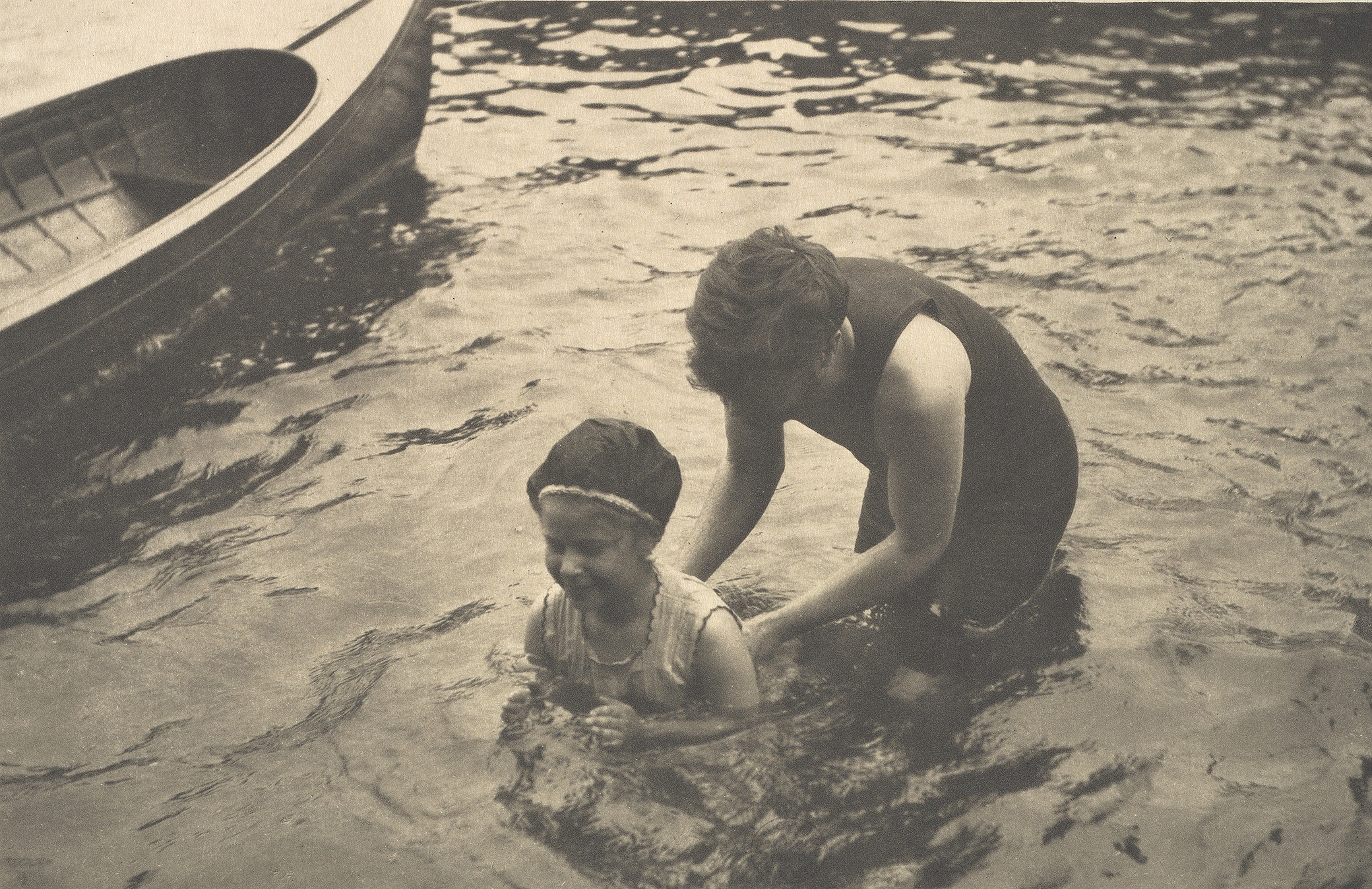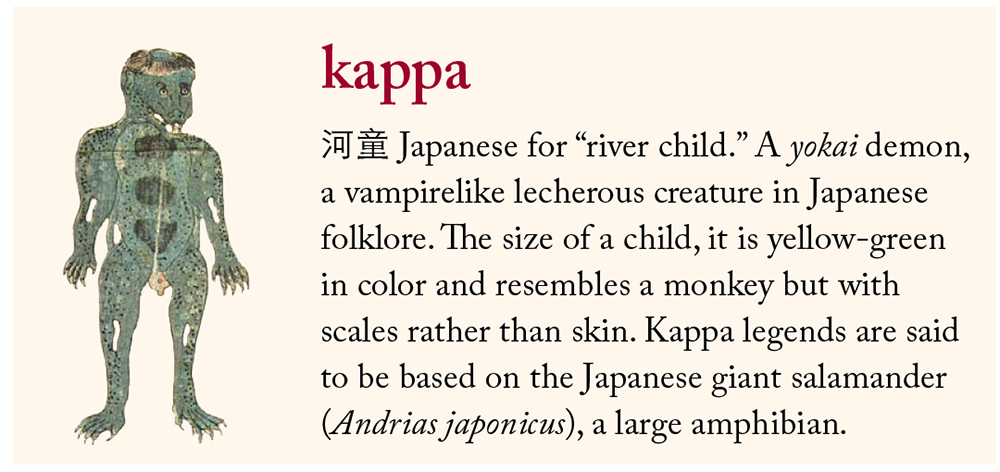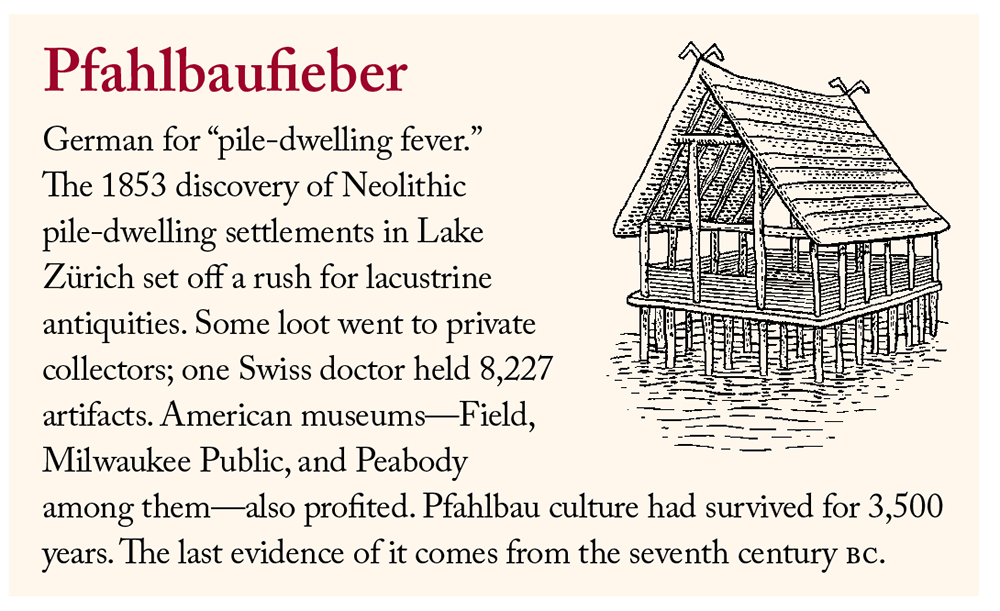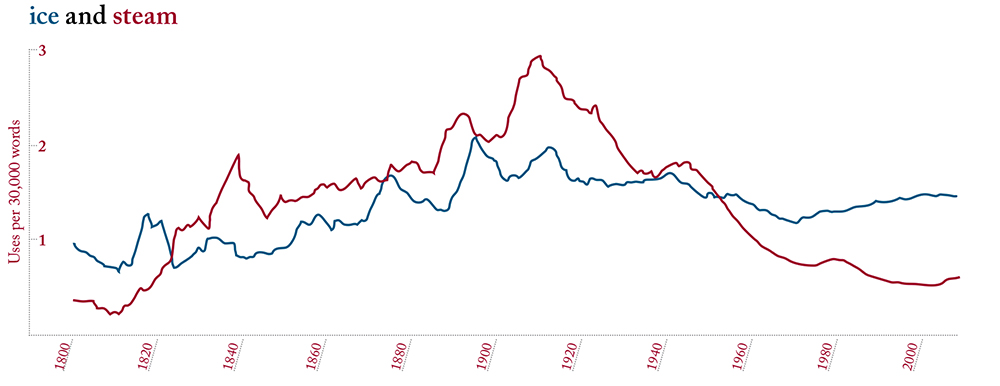
The Swimming Lesson, 1906. Photograph by Alfred Stieglitz. The Metropolitan Museum of Art, Gift of J.B. Neumann, 1958.
acre-foot: The amount of water that is needed to cover an acre of land one foot deep (approximately 326,000 gallons).
aggressive water: Water that is soft and acidic; such water quickly erodes plumbing.
antediluvian: Of or relating to the period before the flood described in Genesis. Also, antiquated, ridiculously old-fashioned, or out-of-date.
antifogmatic: An alcoholic liquor taken to counteract the effects of damp or wet.
aqilokoq: Inuit for “softly falling snow.” Contrary to earlier studies, the Inuit dialect spoken in Canada’s Nunavik region does have at least 53 words for snow.
artesian well: A well bored perpendicularly into water-bearing strata; natural pressure provides constant water with little or no pumping. From French artesian, of or relating to the province of Artois, where the technique originated.
backswimmer: Any of a group of insects of the family Notonectidae that are found worldwide and are named for their ability to swim on their backs.
baptism: Derived from Greek verb βάπτω, dip, which in turn may be traced to reconstructed Indo-European gabh-, dip.
bathroom: A room containing a toilet or toilets, usually with facilities for hand washing, and sometimes also a bath or shower. Orig. and chiefly N. Amer. First used as a euphemism for toilet, 1883.
blackwater: Water containing waste from humans, animals, or food.
carafe: A glass water bottle for the table, bedroom, etc. From French carafe, Italian caraffa, Sicilian carrabba. According to Émile Littré, it was identified by Julius von Mohl with Persian qarābah, a flagon, but Reinhart Dozy refers it to Arabic gharafa, to draw or lift water.
cha shui biao: 꿴彊깊 Chinese for “check water meter.” Used in response to possibly subversive comments, suggesting that police or other authorities will arrest the commenter under the guise of inspecting a water meter.
dive: (v.) Of a submarine, to submerge. “Its speed was lessened: sometimes it kept on the surface, sometimes it dived to avoid a vessel.”—Jules Verne, 20,000 Leagues Under the Sea (1870). Modern past-tense form dove (1855) is apparently a new formation after drove, wove, etc.
eau de cologne: A citrus perfume originally mixed in Cologne by Giovanni Maria Farina in 1709.
firn: Old snow that has become granular and dense under the action of various processes of melting and refreezing, including sublimation and crystallization.
fog: A thick, obscuring mist. Origin obscure, possibly from Danish fog, spray, shower, or Old Norse fjúk, drifting snowstorm. Compare Old English fuht, German Feucht, damp, moist.
gletscher: A glacier. From German gletscher; adopted in 16th cent. from Swiss dialect for French glacier.
hogwash: (depreciative) A liquid for drinking that is of poor quality; also, nonsense, esp. worthless, ridiculous, or nonsensical ideas. “Your butler purloins your liquor, and your brewer sells you hogwash.”—John Arbuthnot, 1712
human wave: A wavelike effect produced in a stadium by successive sections of the crowd of spectators standing up, raising arms, and sitting down again. This form of crowd participation became popular among spectators at World Cup matches in Mexico City in 1986, thus also Mexican wave.
hydropot: A water drinker; one who abstains from alcohol. From Greek ὑδροπότης, water drinker; in French, hydropote.
iceblink: “A name given by seamen to a bright appearance near the horizon, occasioned by the ice, and observed before the ice itself is seen.”—Webster’s American Dict. of the English Language (1828)

knucker: In Sussex, a water dragon. From Old English nicor, water monster.
leaker: One who discloses secret information. First use, 1969.
levee: An embankment to prevent the overflow of a river. From French levée, feminine of levé, past participle of lever, to raise.
liquidity: (Obs.) Rarefied condition, subtlety. Also, the quality of being financially liquid (1879).
maximum contaminant level: The highest level of a contaminant permitted in drinking water.
mist: A cloud of vapor. In meteorology, mist is distinguished from fog as being less opaque, with visibility of at least one kilometer, and from haze, which is due to solid particles, not water droplets. Inherited from Germanic; extended form of the Indo-European base of Sanskrit mih, mist, vapor, megha, cloud; Greek ὀμίχλη, mist, cloud.
Neopluvial: A phase of the late Holocene epoch of wetter and colder climate in the American West.
overdraft: An extraction of groundwater at a rate so in excess of replenishment that groundwater levels decline persistently.

pool party: First use, 1913. Described in the New York Times as “a new wrinkle in entertainment.”
POPs: Persistent organic pollutants, compounds not easily biodegraded.
puddle: A pool of standing water. Origin uncertain, probably related to Middle Dutch podel, poedel, in the compound podelpoel, mud pool, and perhaps also in the place-names Pudelwiic, Poedelwike, after a district in Holland. Compare also German regional Pfudel, Pudel, pool, puddle.
rainmaker: A person who generates income for a company or an organization, esp. by attracting clients. First use, 1897.
seltzer: An effervescent mineral water obtained near Nieder-Selters containing sodium chloride as well as sodium, calcium, and magnesium carbonates. Also, an artificial mineral water of similar composition. From German Selterser, Selters, the name of a village in Hesse. Compare French seltz, selz.
slur: A thin or fluid mud. Of obscure origin; compare Dutch sloor, sloerie, Middle Dutch slore, a sluttish woman.
slush: A watery substance resulting from partial melting of snow or ice. Of obscure origin; the word’s late appearance makes it doubtful there is a connection with such forms as older Danish slus, sleet, mud, or Norwegian slusk, slops, sloppy ground, or weather.
snow job: Deception, insincere charm.
sold down the river: To be betrayed or cheated. From Ohio River and Mississippi River slave trade; slaves were shipped south, where conditions were more brutal. Between 1850 and 1860, 193,000 slaves were transported across state lines.

swim: (v.) To conform to prison society.
virgula divina: (Obs.) A dowsing rod; a forked stick (typically of hazelwood) used to discover groundwater.
vodyanoy: In Slavic mythology, a male water goblin. From Russian водяной, watery. Local drownings are considered to be the work of the vodyanoy, which lures unwary humans to their death in the water.
water birth: The act of defecating in a swimming pool.
Explore Water, the Summer 2018 issue of Lapham’s Quarterly.